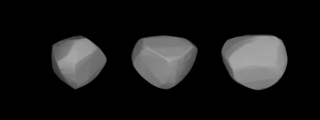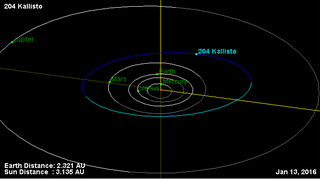
26 Proserpina is a main-belt asteroid discovered by German astronomer R. Luther on May 5, 1853. It is named after the Roman goddess Proserpina, the daughter of Ceres and the Queen of the Underworld. Another main-belt asteroid, 399 Persephone, discovered in 1895, is named after her Greek counterpart. Its historical symbol was a star inside a pomegranate; it is in the pipeline for Unicode 17.0 as U+1CECD .

34 Circe is a large, very dark main-belt asteroid. It was discovered by French astronomer J. Chacornac on April 6, 1855, and named after Circe, the bewitching queen of Aeaea island in Greek mythology.

68 Leto is a large main belt asteroid that is orbiting the Sun. The asteroid was discovered by German astronomer Robert Luther on April 29, 1861, and is named after Leto, the mother of Apollo and Artemis in Greek mythology. It orbits at a distance of 2.78112 AU over 4.64 years and has an orbital eccentricity of 0.187. The orbital plane is inclined at an angle of 7.97° to the ecliptic.

76 Freia is a very large main-belt asteroid. It orbits in the outer part of the asteroid belt and is classified as a Cybele asteroid. Its composition is very primitive and it is extremely dark in color. Freia was discovered by the astronomer Heinrich d'Arrest on October 21, 1862, in Copenhagen, Denmark. It was his first and only asteroid discovery. It is named after the goddess Freyja in Norse mythology.

84 Klio is a fairly large and very dark main-belt asteroid. It was discovered by R. Luther on August 25, 1865, and named after Clio, the Muse of history in Greek mythology. The name Clio had previously been suggested by the discoverer of 12 Victoria, and that is the name B. A. Gould, editor of the prestigious Astronomical Journal, adopted for that asteroid, because of the controversy over the name Victoria. An occultation by Klio over a dim star was observed on April 2, 1997.

98 Ianthe is a large main-belt asteroid, named for three figures in Greek mythology. It is very dark and is composed of carbonates. It was one of the numerous discoveries by C. H. F. Peters, who found it on April 18, 1868, from Clinton, New York.

102 Miriam is a moderately large, very dark main belt asteroid. It was discovered by C. H. F. Peters on August 22, 1868, from the Litchfield Observatory.

117 Lomia is a large main-belt asteroid that has a nearly circular orbit; the orbital eccentricity is 0.029. It was discovered by French astronomer Alphonse Borrelly on September 12, 1871, from the Marseilles Observatory. The preliminary orbital elements were published in the following year by German astronomer Friedrich Tietjen. The reason for the name is uncertain, but Lutz D. Schmadel believes it is most likely a misspelling of Lamia, the female demon of Greek mythology.

168 Sibylla is a large main-belt asteroid, discovered by Canadian-American astronomer J. C. Watson on September 28, 1876. It was most likely named for the Sibyls, referring to the Ancient Greek female oracles. Based upon its spectrum this object is classified as a C-type asteroid, which indicates it is very dark and composed of primitive carbonaceous materials. 168 Sibylla is a Cybele asteroid, orbiting beyond most of the main-belt asteroids.

193 Ambrosia is a main belt asteroid that was discovered by the Corsican-born French astronomer J. Coggia on February 28, 1879, and named after Ambrosia, the food of the gods in Greek mythology.

204 Kallisto is a fairly typical, although sizeable Main belt asteroid. It is classified as an S-type asteroid. Like other asteroids of its type, it is light in colour. It was discovered by Johann Palisa on 8 October 1879, in Pola, and was named after the same nymph Callisto in Greek mythology as Jupiter's moon Callisto.

221 Eos is a large main-belt asteroid that was discovered by Austrian astronomer Johann Palisa on January 18, 1882, in Vienna. In 1884, it was named after Eos, the Greek goddess of the dawn, to honour the opening of a new observatory that was hoped to bring about a new dawn for Viennese astronomy.

334 Chicago is a very large main-belt asteroid. It is classified as a C-type asteroid and is probably composed of carbonaceous material.

404 Arsinoë is a large main-belt asteroid. It is classified as a C-type asteroid and is probably composed of carbonaceous material.
419 Aurelia is a main-belt asteroid that was discovered by German astronomer Max Wolf on September 7, 1896, in Heidelberg. It is classified as an F-type asteroid.
420 Bertholda is a very large main-belt asteroid. It was discovered by Max Wolf on September 7, 1896, in Heidelberg, Germany. The object is part of the Cybele asteroid group, and is classified as a P-type asteroid.
536 Merapi is a main belt asteroid orbiting the Sun. It was discovered by American astronomer George Henry Peters on May 11, 1904, from Washington, D.C.
650 Amalasuntha is a minor planet orbiting the Sun that was discovered by German astronomer August Kopff on October 4, 1907, at Heidelberg. It was named after Amalasuntha, the queen of the Ostrogoths from 526 to 534 AD. The name may have been inspired by the asteroid's provisional designation 1907 AM.

720 Bohlinia is a minor planet orbiting the Sun that was discovered by Franz Kaiser, a German astronomer in 1911. It is named for Swedish astronomer Karl Petrus Theodor Bohlin, to mark his 65th birthday. He had worked on the orbits of asteroids.
790 Pretoria is a minor planet orbiting the Sun that was discovered by English astronomer Harry Edwin Wood on January 16, 1912. It is a member of the Cybele group located beyond the core of the main belt and named after Pretoria, the capital city of South Africa.















